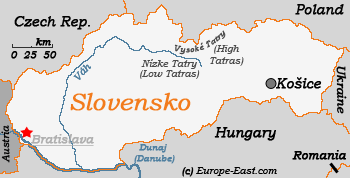Official name
Slovenská Republika (Slovak Republic), commonly abbreviated Slovensko - not to be confused with Slovenija (Slovenia). In English, the country is mostly known as Slovakia. Slavic tribes once referred to themselves as Slověne - and so the country name simply derives from the word "Slav". Therefore, similar names can be found elsewhere - Slovenia, →Slavonia etc. Hungarians referred to the same area as Upper and Lower Hungary during the Austro-Hungarian monarchy.
Area & Population

| ||
| Clickable Map of Slovakia |
48,845 km² - slightly larger then Denmark or Connecticut and Maryland combined.
some 5.4 million* (2004). With 111 inhabitants per square kilometer it's rather sparsely populated compared to Central Europe.
The Slovakian population is comparatively homogeneous - around 85.8% are Slovak, 9.7% Hungarians, 1.7% Roma (no reliable number, though), 0.8 % Czechs, 0.4 % Ruthenians and 0.2%Ukrainians. Furthermore, there are very small Jewish, German, Silesian and other communities. (estimation from 2004).*
Religion
Around 10% of the Slovaks stated that they do not belong to any faith. The majority, around 60.3%, is Roman-Catholic, 8.4% are Protestants, 4.1% orthodox, others are 17.5%.
Time zone
GMT +01 hr (Central Europe Time), with daylight-saving time (+1 hour) in summer.
Slovak. This language is part of the West Slavic branch of the so-called Satem languages, which again is part of the large Indo-European language family. The closest language is definitely the →Czech language, though Slovaks can also communicate to a certain extent with →Poles.
In the past, Czech was widely used - especially in documents - and so the Slovak language moved closer to Czech. Slovak didn't have it's own written language before the 18th century. As in many other languages, Slovak uses 6 grammatical cases (the 7th, called vocative, was abandoned). A distinctive feature of Slovak is the large number of Hungarian loanwords. Furthermore, many words, some endings and even some letters and their pronunciation are different to the Czech and Polish language. It also features an interesting curiosity called rhythmical contraction - this rule says that a long syllable (i.e. a syllable containing a long vowel) cannot be followed by another long syllable. Hence, one syllable becomes short. Of course, exceptions prove the rule.
The following Slovak letters do not exist in English, have a different pronunciation or they are completely different to Czech:
- á é í ó ú ý : All of these diacritic vowels are long - as the [ar] in [hard] for example. [ í ] and [ ý ] basically share the same pronunciation - similar to [ee]
- ä : As the German umlaut [ä] or as the [a] in [man]. However, the pronunciation more and more switches towards the [e] in [get].
- c : Always pronounced as the [ts] in [tsar].
- č : Voiceless [tch] as in [dutch].
- ď : Dj - a D followed by a soft [j]. Similar to the vowel in the [du] in [due].
- dz : Voiced [ds] Similar to the Italian [zz].
- dž : Voiced [dsh], close to the [g] in [gin].
- ľ : Lj, L, followed by a j. Similar to the [lli] in [million].
- ň : Nj, similar to the [ny] in [canyon] (Spanish [ñ].
- ô : A contracted [uo] ( əʊ ), similar to the [ow] in [know].
- š : Voicelass [sh], as in [ rush ].
- ť : Tj, t with a j. Similar to [tu] in [tune].
- v : as a [v]. but at the end of a word closer to a [w].
- ž : Voiced [sh], as the [s] in loanwords such as [leisure].
In Slovak, it's always the first syllable that is stressed. It's fairly easy to get around with →Czech. Travellers familiar with Russian will understand many words, but it's rather difficult to make yourself clear with Russian only. Many people speak English and/or German.
→Click here for a comparison of some important vocabulary in Polish with many other Slavic languages.
©2024 Europe-East.com

 Albania
Albania